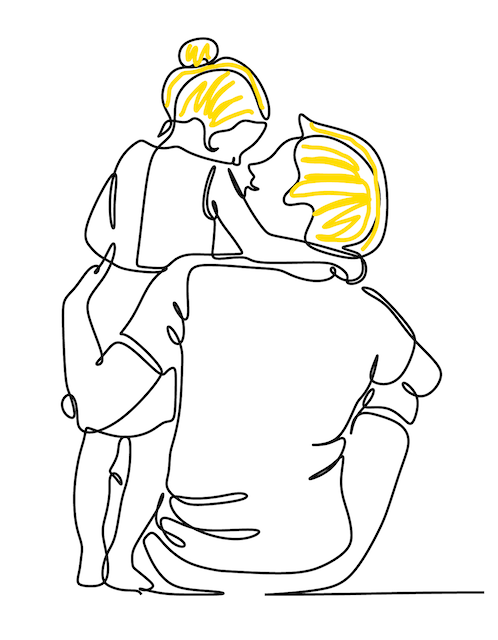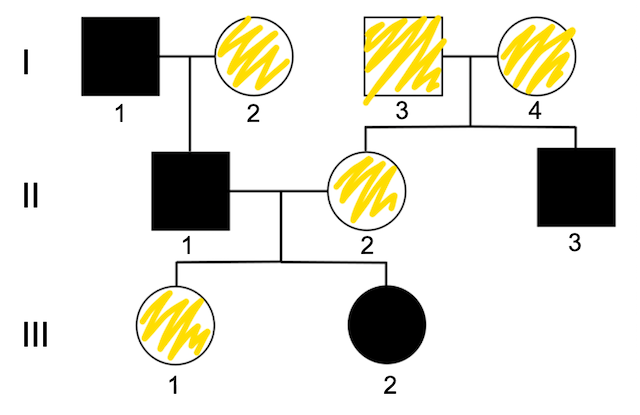An Everyday DNA blog article
By: Sarah Sharman, PhD, Science Writer
It’s Thanksgiving Day 2020 and your cousin is showing off her new baby to the ‘Zoomsgiving’ crew. She is the cutest, most bubbly baby you have ever seen. But while everyone is coo-ing at the baby, you notice something peculiar—the baby has red hair. No one in your family has red hair.

Another glance around the virtual Thanksgiving table might bring up some other interesting questions about your family members. Where did my blue eyes come from? How is it possible that my uncle is the only left-handed person at the table?
Some of these genetic mysteries can be debunked using a genetic tool called a pedigree. But before we learn how to create a family pedigree, let’s discuss traits.
What are traits?
A genetic trait is a specific characteristic of an individual, such as hair, eye, and skin color, height, blood type, and handedness to name a few. Traits are determined by genes, but they can also be affected by environmental influences on genes.
 Our traits are inherited from our parents in segments of DNA called alleles, one from our mom and one from our dad. Traits can be dominant or recessive with dominant traits being expressed over recessive traits. Depending on your parents’ alleles, you might inherit two dominant alleles or two recessive alleles, called homozygous, or one dominant and one recessive allele, called heterozygous.
Our traits are inherited from our parents in segments of DNA called alleles, one from our mom and one from our dad. Traits can be dominant or recessive with dominant traits being expressed over recessive traits. Depending on your parents’ alleles, you might inherit two dominant alleles or two recessive alleles, called homozygous, or one dominant and one recessive allele, called heterozygous.
The recessive trait is only expressed if you inherit two recessive alleles. Blue eyes are recessive to brown eyes so if you inherit a dominant brown eye allele from mom and a recessive blue eye allele from dad, your eyes will express the dominant trait and be brown.
People that have one dominant allele and one recessive allele are referred to as carriers of the recessive trait. This means that although they do not express the recessive trait themselves, they could still pass the recessive allele on to their offspring.
It is important to note that some traits are linked to several alleles so their inheritance patterns are not as straightforward as just inheriting a dominant or recessive allele from your mom or dad but that is a separate blog post for another day. Now that we understand basic traits, let’s learn how to track a trait through a few familial generations.
Pedigree: a genetic representation of a family tree
Pedigrees are useful tools for visualizing your family tree and diagramming the inheritance of a trait or disease through several generations. They diagram the relationships between family members through the use of standardized symbols—squares represent males, and circles represent females. Each horizontal row of symbols represents a generation and is labeled with a Roman numeral starting with the oldest generation. Individuals in the generation are numbered from left to right. Parents are connected by a horizontal line and a vertical line leads to their children.
 If an individual has the inherited trait being tracked, like blue eyes for example, their square or circle is shaded to indicate the presence of that trait. The three black squares and one black circle on the pedigree above represent individuals with blue eyes. If I am individual 2 in generation III, this means that my dad, my maternal uncle, my paternal grandfather and I all have blue eyes. The rest of the family members on the pedigree are carriers for the blue eye allele but do not express blue eyes because they have a more dominant eye color allele, like brown or green, that is expressed.
If an individual has the inherited trait being tracked, like blue eyes for example, their square or circle is shaded to indicate the presence of that trait. The three black squares and one black circle on the pedigree above represent individuals with blue eyes. If I am individual 2 in generation III, this means that my dad, my maternal uncle, my paternal grandfather and I all have blue eyes. The rest of the family members on the pedigree are carriers for the blue eye allele but do not express blue eyes because they have a more dominant eye color allele, like brown or green, that is expressed.
Using a pedigree of at least three generations allows geneticists to determine how a particular trait is inherited. Pedigrees might be able to determine the chance that a given individual will have the trait themselves or could pass it on to their children. For example, if you have the dominant brown eye allele and the recessive blue eye allele and marry someone with the recessive blue eye allele, your children have a chance of having blue eyes.
Interesting traits and their inheritance patterns
For a fun activity to try while letting your Thanksgiving meal digest, try drawing a pedigree for your family using the information described above. You might find out that you potentially carry a recessive allele for an interesting trait like blue eyes, attached earlobes, or red hair. To help you begin here is a list of some traits that are thought to be dominant or recessive that you can try to track through your family pedigree.
Dominant Traits
– Detached earlobes
– Ability to roll your tongue
– Dimples
– Cleft chin
– Widow’s peak hairline
– Right-handedness
– Naturally curly hair
– Freckles
– ‘A’ blood type
– Having six fingers
Recessive Traits
– Attached earlobes
– No tongue rolling
– No Dimples
– No cleft in chin
– Straight hairline
– Left-handedness
– Straight hair
– No freckles
– ‘O’ blood type
– Having five fingers


